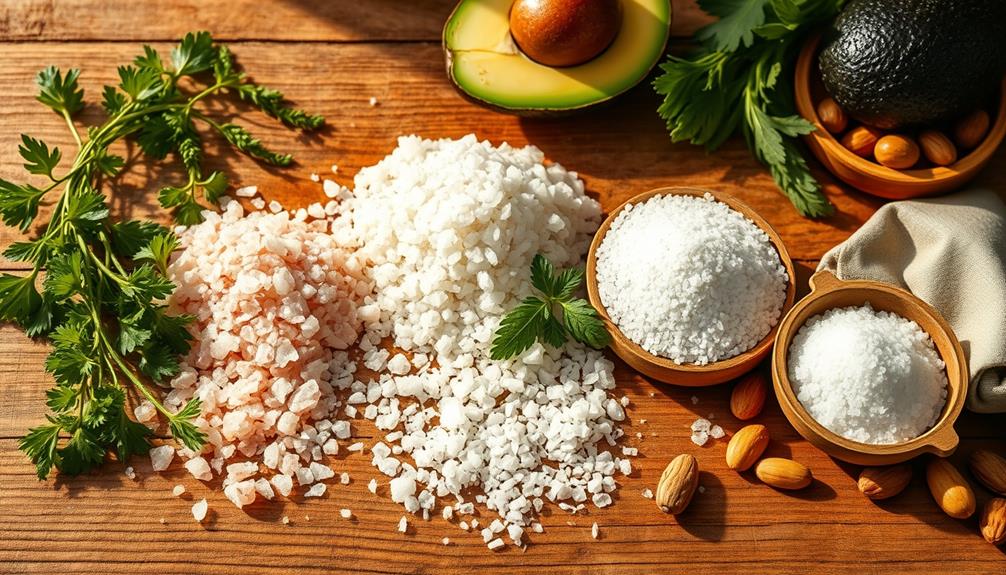If you’re choosing between almond and coconut flour for keto baking, consider their differences: almond flour adds moisture, protein, and healthy fats for a richer texture, while coconut flour provides more fiber and absorbs liquids quickly, requiring adjustments. Almond flour is ideal for cookies and muffins, whereas coconut flour works well in dense bread or cakes. Exploring their unique qualities can help you perfect your keto recipes—keep going to discover how to get the best results.
Key Takeaways
- Almond flour provides more protein and healthy fats, ideal for moist, dense baked goods like muffins and bread.
- Coconut flour is higher in fiber and lower in carbs, making it suitable for digestion and weight management.
- Almond flour can often be substituted directly for wheat flour, while coconut flour requires more liquids and eggs due to high absorbency.
- Combining both flours can balance texture and improve baking results in keto recipes.
- Choose based on your dietary goals: protein and fats with almond flour, fiber and low carbs with coconut flour.

When choosing between almond flour and coconut flour, understanding their unique properties can help you make the right choice for your baking needs. Both flours are popular in keto diets, but they differ markedly in nutritional content and how they perform in recipes. Knowing these differences allows you to adapt your baking techniques effectively and achieve the best results. Almond flour, made from ground almonds, is rich in healthy fats, protein, and fiber. It offers a more substantial, moist texture, making it ideal for baked goods like muffins, cookies, and bread. Coconut flour, on the other hand, is derived from dried coconut meat, and is high in fiber and healthy fats but lower in protein. Its fine, powdery texture absorbs a lot of moisture, which influences how you should use it in recipes.
In terms of nutritional differences, almond flour provides a good amount of protein and monounsaturated fats, which support heart health and satiety. Coconut flour is lower in calories and carbs but packs a punch with its high fiber content, aiding digestion and helping you feel full longer. Because of these variations, your choice impacts not only nutrition but also baking techniques. Almond flour’s moisture content and fat levels mean you can often substitute it directly for traditional wheat flour with minimal adjustments. It tends to produce softer, denser baked goods, so you might want to add a little extra liquid or eggs to compensate for the fat and moisture. Coconut flour, however, requires more careful handling. Its high absorbency means you usually need to add more liquids or eggs to prevent dry, crumbly results. Many recipes recommend replacing only a portion of traditional flour with coconut flour or combining it with other flours to improve texture.
Your baking techniques must adapt to these differences. When using almond flour, you can generally follow recipes as written but should be mindful of the extra moisture. For coconut flour, expect to tweak the amounts of liquids and eggs, and consider blending it with other flours for a more balanced texture. Additionally, because coconut flour tends to make baked goods drier, adding fats like coconut oil or butter can help improve moistness. Both flours require some experimentation, but understanding their nutritional differences and how they influence baking techniques will help you create keto-friendly treats that are both delicious and nutritious. Furthermore, some bakers recommend using additional binders like eggs or xanthan gum to improve the structure of coconut flour baked goods. Ultimately, your choice depends on your dietary goals and the texture you want, but mastering these distinctions will boost your confidence in keto baking.
Frequently Asked Questions
Can Almond and Coconut Flour Be Used Interchangeably in Recipes?
You can’t always swap almond and coconut flour directly because of substitution flexibility and flavor compatibility. Almond flour has a milder, nutty taste and absorbs more moisture, while coconut flour is more absorbent and has a distinct coconut flavor. To successfully substitute, you often need to adjust the recipe’s liquid and egg content. Experiment carefully, and remember that each flour’s unique properties can affect texture and flavor.
How Do Almond and Coconut Flour Affect Blood Sugar Levels?
Did you know that almond flour has a glycemic index of around 1, making it very low impact on blood sugar levels? When you use almond or coconut flour, you generally experience a minimal blood sugar impact compared to traditional flours. Coconut flour has a slightly higher glycemic index but still keeps your blood sugar stable if eaten in moderation. Both options help you manage blood sugar levels effectively.
Are There Allergy Considerations With Almond and Coconut Flour?
If you have a nut allergy or digestive sensitivity, be cautious with almond flour, as it contains nuts that could trigger reactions. Coconut flour is generally safer for nut allergies but may cause digestive issues like bloating or gas in some people. Always check labels and consider doing a small allergy test before incorporating these flours into your keto baking to avoid adverse reactions.
What Is the Shelf Life of Almond Versus Coconut Flour?
Almond flour typically lasts 6 to 12 months when stored properly in an airtight container in a cool, dark place, while coconut flour has a slightly shorter shelf life of about 4 to 6 months. To maximize freshness, keep both gluten free benefits in mind by storing them away from heat and humidity. Use airtight containers and consider refrigeration for longer storage, especially in humid environments.
How Do Flavor Profiles Differ Between Almond and Coconut Flour?
When it comes to flavor nuances, almond flour offers a mild, nutty taste that complements a variety of recipes, while coconut flour has a distinct, sweet, and tropical flavor that can stand out. You’ll find coconut flour’s taste more prominent, but it also adds to its culinary versatility. Keep in mind, it’s a case of apples and oranges, so choose based on the flavor profile you want to achieve in your baked goods.
Conclusion
So, whether you prefer the nutty richness of almond flour or the subtle sweetness of coconut flour, both can turn your keto baking into something special. It’s funny how a simple choice can remind you of family gatherings or quiet mornings at home. Sometimes, the best recipes come from trying new ingredients just when you least expect it. Trust your taste buds—your perfect keto bake might be just a flour switch away from turning your day around.








